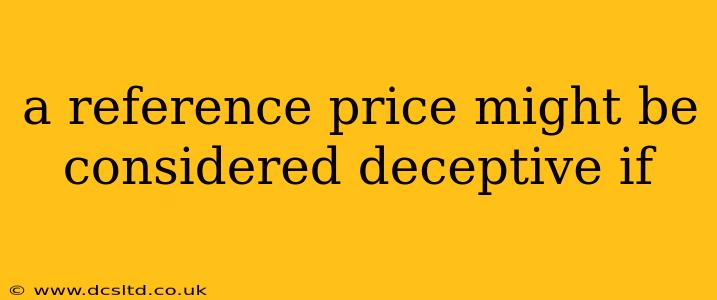Reference prices, those suggested prices alongside a sale price, are ubiquitous in marketing. They aim to highlight a deal, making a product or service seem more attractive. However, a reference price can easily cross the line from helpful suggestion to deceptive tactic. This article explores the situations where a reference price might be considered deceptive, protecting both consumers and businesses from potential legal and ethical pitfalls.
What Makes a Reference Price Deceptive?
A reference price becomes deceptive when it misleads consumers about the actual value or savings involved in a purchase. This can manifest in several ways:
-
Fictitious or Inflated Reference Prices: The most blatant form of deception is using a reference price that never existed or is significantly higher than the product's typical retail price. This creates a false sense of a substantial discount. For example, claiming a $100 item is "marked down" from $250 when it's rarely, if ever, sold at the higher price.
-
Lack of Transparency: A deceptive reference price is often accompanied by a lack of transparency. Consumers are not given enough information to verify the validity of the reference price. This can include the absence of clear evidence demonstrating the reference price represents a genuine previous selling price, or lack of information about the timeframe for that previous price.
-
Misleading Comparisons: Comparing the sale price to a reference price that represents a different product, quantity, or quality is misleading. For instance, comparing the price of a single item to a reference price for a bulk package or a superior model.
-
Hidden Fees: A seemingly attractive sale price with a low reference price can be undermined by hidden fees or charges added later in the purchasing process, diminishing the perceived savings. This erodes consumer trust and can lead to legal challenges.
-
Regular Sales: If a product is constantly "on sale" with a similarly inflated reference price, consumers quickly recognize this as a deceptive practice. The implication of a genuine discount is lost when sales become the norm rather than an exception.
How to Identify a Deceptive Reference Price
Several red flags suggest a deceptive reference price:
- The reference price is significantly higher than similar products. Cross-check the pricing of the same or comparable items from other retailers.
- There's a lack of evidence supporting the stated reference price. Look for proof that the product has ever sold at that price.
- The advertised discount is unrealistically high. Extremely large discounts (e.g., 90% off) should trigger skepticism.
- The retailer has a history of frequent sales and inflated reference prices. Research the retailer's past pricing practices.
What are the legal implications of using a deceptive reference price?
Using deceptive reference pricing can lead to legal repercussions, depending on the jurisdiction. Many consumer protection laws prohibit unfair or deceptive business practices, including the use of misleading reference prices. Penalties can involve substantial fines, legal action, and damage to reputation.
How can businesses avoid deceptive reference pricing?
Businesses can avoid using deceptive reference prices by:
- Using verifiable reference prices: Ensure that the reference price accurately reflects a genuine previous price for the same product. Document this with sales data.
- Being transparent: Clearly and prominently display information about the reference price, including the period during which the product was sold at that price.
- Making fair comparisons: Compare only similar products, quantities, and qualities.
- Disclosing all fees: Ensure all fees and charges are clearly stated upfront, avoiding any hidden costs.
- Avoiding overly frequent sales: Regularly offering large discounts with inflated reference prices can undermine consumer trust.
By understanding the factors that constitute deceptive reference pricing, both consumers and businesses can ensure fair and ethical pricing practices, protecting consumers from manipulation and upholding the integrity of the marketplace. Remember, a well-intentioned marketing strategy shouldn't compromise honesty and transparency.
